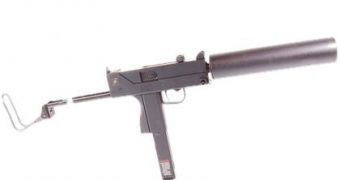Gun suppressors, most commonly known as silencers, are generally used to 'quiet' down the loud bang created by the sudden expansion of the explosive discharge that is propelling the bullet out of the gun barrel and through the air. The vast majority of guns are not built to accept suppressors, although some are specially designed so that silencers can be screwed at the gun barrel aperture from where the bullet emerges as the gun is fired.
The typical pressure of the gas expanding behind the bullet as it exits the barrel is somewhere around 210.9 kilograms per square centimeter. That's pretty high as compared to the normal atmospheric pressure, which is why as the gas exits it expands rapidly and creates an air Shockwave that we experience as a loud bang. If suppressors are used however, the pressure of the escaping gas can be reduced to as little as 4.2 kilograms per square centimeter.
The difference is quite obvious. The sound produced when a suppressor is used is at least 50 times smaller than the one generated without the silencer.
How it works
Suppressors generally consist of a hollow cylindrical metal shirt containing a series of expansion chambers. These are 'can'-type suppressors, because they resemble the shape of a beverage can and can be attached directly to the muzzle of a gun. A second type of widely used suppressors is the 'integral'-type, whose expansion chamber partially surrounds the barrel of the gun.
To understand the functioning of a gun suppressor, one must imagine a more common analogy. Imagine a balloon filled with air. If you pop the balloon with a pin, the air inside it rapidly decompresses into Earth's atmosphere and produces a characteristic loud sound. However, if you were to slowly let the air out of the balloon, the generated sound would be much softer.
This is exactly how gun suppressors work. Gas expanding at fast rates behind the fired bullet is temporarily trapped inside the hallow chambers of the suppressor. There it cools and expands, after which it leaves the suppressor at low pressure and velocity. The larger the expansion chambers, the smaller the sound produced as the bullet exits the barrel.

 14 DAY TRIAL //
14 DAY TRIAL //